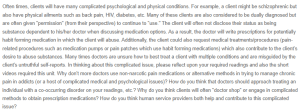Pain, Addiction, and Prescription Misuse in Dual Diagnosis Clients
There are many reasons why physicians feel reluctant to recommend non-narcotic analgesics or other forms of therapy. One is the belief that narcotic pain medicines are ideal for treating severe pain, even if they are addictive. Furthermore, there exists poor knowledge and preparedness concerning other forms of managing pain among healthcare professionals. Still, crucial to the management of dual diagnosis is that doctors should employ a biological and psychological model when managing a patient. This includes carrying out a comprehensive medical and psychological evaluation and reporting to the patient (Anees Bahji, 2024). Non-pharmacological and non-opioid therapies like physical therapy, psychotherapy and other non-opioid medicines should be used first.
Clients often “doctor shop” to obtain prescription medications due to addiction-driven behaviors and the desire for specific drugs that they know will provide the relief they seek, whether for pain or psychological distress. This behavior underscores the need for integrated care and communication among healthcare providers to prevent abuse.
Through the provision of client care and support, access to other treatment options and care coordination, human service providers influence this matter by creating awareness among clients by educating them against the use of narcotic medications. However, they can worsen the situation if they do not notice the signs of abuse or if they do not interact with other healthcare workers (National Academies of Sciences et al., 2019).
References
Anees Bahji. (2024). Navigating the complex intersection of substance use and psychiatric disorders: A comprehensive review. Journal of Clinical Medicine, 13(4), 999–999. https://doi.org/10.3390/jcm13040999
National Academies of Sciences, E., Division, H. and M., Policy, B. on H. S., Services, B. on H. C., Illness, R. on Q. C. for P. with S., Alper, J., Olchefske, I., & Graig, L. (2019, May 1). Proceedings of a Workshop. Www.ncbi.nlm.nih.gov; National Academies Press (US). https://www.ncbi.nlm.nih.gov/books/NBK544145/
ORDER A PLAGIARISM-FREE PAPER HERE
We’ll write everything from scratch
Question 
DB 6.2

Pain, Addiction, and Prescription Misuse in Dual Diagnosis Clients
Often times, clients will have many complicated psychological and physical conditions. For example, a client might be schizophrenic but also have physical ailments such as back pain, HIV, diabetes, etc. Many of these clients are also considered to be dually diagnosed but are often given “permission” (from their perspective) to continue to “use.” The client will often not disclose their status as being substance dependent to his/her doctor when discussing medication options. As a result, the doctor will write prescriptions for potentially habit forming medication in which the client will abuse. Additionally, the client could also request medical treatments/procedures (pain-related procedures such as medication pumps or pain patches which use habit forming medications) which also contribute to the client’s desire to abuse substances. Many times doctors are unsure how to best treat a client with multiple conditions and are misguided by the client’s untruthful self-reports. In thinking about this complicated issue, please reflect upon your required readings and also the short videos required this unit. Why don’t more doctors use non-narcotic pain medications or alternative methods in trying to manage chronic pain in addicts (or a host of complicated medical and psychological issues)? How do you think that doctors should approach treating an individual with a co-occurring disorder on your readings, etc.? Why do you think clients will often “doctor shop” or engage in complicated methods to obtain prescription medications? How do you think human service providers both help and contribute to this complicated issue?
NOTE: You must make at least 1 substantial posting and 2 substantial replies to this thread. You must participate in the Unit discussion board (making postings/replies) at least 3 days per unit to qualify for full credit and also have at least 1 posting by Wednesday at midnight. You also must use APA style in your posting and replies so please use in-text references and provide a reference to give proper credit to the authors.
